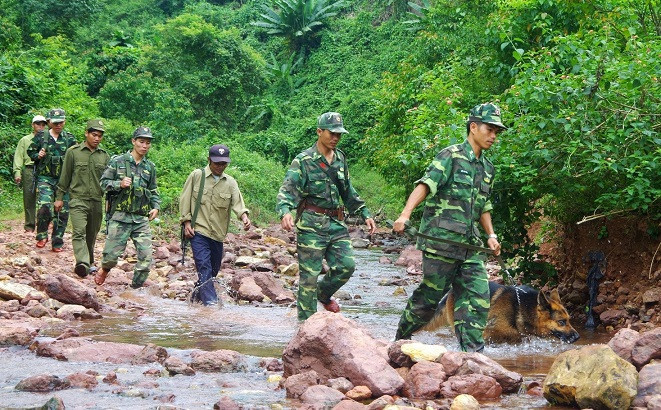
Noong Ma village cluster is located in Hin Nam No National Conservation Area in Bua La Pha district, Kham Muon province of Laos. This village is near the Vietnam - Laos border, bordering Thuong Trach commune, Bo Trach district, Quang Binh province of Vietnam.
For many years, every time they need medical examination, treatment or medicine... people living in Noong Ma village cluster often go to the Military and Civilian Medical Station of Village 61 run by Ca Roong Border Guard Station (under the Border Guard of Quang Binh province) in Vietnam to ask for help. Many people who came for a medical examination were also treated and cared for by officers and soldiers at the station until they recovered.
The Military and Civilian Hospital Station 61, in addition to serving the people and soldiers in the border area of Thuong Trach commune, also serves a large number of residents in the Noong Ma village cluster of Laos.
Not only do they come for medical examination and medicine, but the villagers also come to buy salt, rice and many other consumer goods.
Knowing that the lives of the people of Noong Ma village are still difficult, the Ca Roong Border Guard Station has many times coordinated with a number of agencies, departments, branches, and philanthropists to bring rice and clothes to present to the villagers.
In Quang Ninh province, for a long time, people living in the border area of two localities, Trang Vi hamlet in Tra Co ward, Mong Cai city (Vietnam) and Van Vi village in Giang Binh town, Dong Hung (China) have lived together in a friendly way. They often cross the border to visit friends and relatives and help each other in life. Especially, since the two sides implemented the twinning of border residential clusters, the relationship between these two localities has become even closer, contributing to keeping peace in the border area.
Van Vi village is just a river away from Trang Vi. This is a village of 5,000 people, of which over 90% are of Vietnamese origin. According to many elderly people in Tra Co (Mong Cai), every year, the people of both Trang Vi and Van Vi regularly organize cultural exchanges, festivals, meetings, visit relatives, and help mutual economic development...
This has helped people on both sides raise awareness, strengthen education for residents on both sides of the border, especially young people, to understand cultural traditions and relationship and long-standing kinship between the two localities, thereby laying the foundation for building a sense of responsibility in border protection and building a peaceful border line.
The activity of twinning among resident clusters at the border is one of the border foreign affairs activities that makes an important contribution to stabilizing the situation of sovereignty, territory, national border security, and strengthening cooperative and trust relationships, and peace with neighboring countries.
In August 2013, Coc Phuong village (Ban Lau commune, Muong Khuong district, Lao Cai province) and Tam Binh Ba group (Nam Khe town, Hekou district, Yunnan province, China) organized residential cluster twinning on both sides of the border. Over the past 10 years, people on both sides of the border have complied and implemented very well the legal documents on management and protection of the Vietnam - China land border; jointly protect national landmarks, do not change border lines, border rivers and streams, firmly protect territorial sovereignty, security and order in border areas.
At the same time, the people of both sides have coordinated and participated in the fight against crime; joining the functional forces of the two countries to prevent and not assist those who illegally buy, sell, transport and store narcotics, human trafficking and goods smuggling.
People from both sides also regularly exchange experiences in developing livestock, production, and cultivation, especially supporting experience and techniques for growing banana and pineapple plants; working together to protect the environment, overcome the consequences of natural disasters, prevent forest fires and epidemics; preserve and promote the traditional cultural identity.
This is one of hundreds of pairs of the twinning model "Residential clusters on both sides of the border" that the Border Guard has effectively implemented.
In recent years, thoroughly grasping and implementing Resolution No. 33 of the Politburo on "National Border Protection Strategy", the Border Guard has organized and implemented many tasks and solutions, among which, foreign affairs is identified as one of the key tasks to contribute to well performing the task of building, managing and protecting national borders. One of the effective activities in foreign affairs is implementing twinning of residential clusters on both sides of the border.
In the past 5 years, the Border Guard has coordinated and advised local authorities in 21/25 land border provinces to organize 207 pairs of "Residential clusters on both sides of the border". In particular, for example, the border line of Thanh Hoa province has organized signing and maintained operations for 17 pairs of villages; Nghe An with 21 pairs; and Quang Ninh with 8 pairs of twinning residential clusters.
Through this activity, people on both sides of the border increasingly demonstrate their awareness and responsibility for protecting national territorial sovereignty, as well as sharing and helping each other in socio-economic development.
At the same time, it creates a spillover and contributes to cultivating and developing the traditional solidarity and friendship between Vietnam's border and border gate management and protection forces of neighboring countries and people on both sides of the border.
In addition, people on both sides of the border also coordinate and actively participate in the fight against crime; voordinate with the two countries' functional forces to prevent and not assist those who illegally buy, sell, transport, store narcotics, human traffickers and smuggle goods.
Thanks to that, people on both sides of the border have complied with and well implemented legal documents on land border management and protection; jointly protecting national borders and landmarks; maintaining security and order, contributing to maintaining border areas of peace, friendship and development; firmly protectng territorial sovereignty.